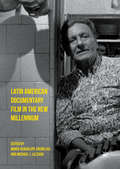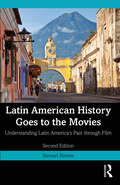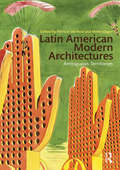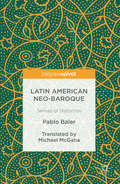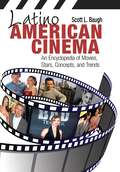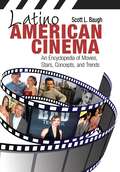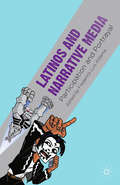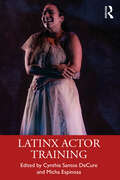- Table View
- List View
Latin American Documentary Film in the New Millennium
by María Guadalupe Arenillas Michael J. LazzaraNearly two decades into the new millennium, Latin American documentary film is experiencing renewed vibrancy and visibility on the global stage. While elements of the combative, politicized cinema of the 1960s and 1970s remain, the region’s production has become increasingly subjective, reflexive, and experimental, though perhaps no less political. At the same time, Latin American filmmakers both respond to and shape global tendencies in the genre. This book highlights the richness and heterogeneity of Latin American documentary film, surveys a broad range of national contexts, styles, and practices, and expands current debates on the genre. Thematic sections address the “subjective turn” of the 1990s and 2000s and the move beyond it; the ethics of the encounter between the filmmaker and the subject/object of his or her gaze; and the performance of truth and memory, a particularly urgent topic as Latin American countries have transitioned from dictatorship to democracy.
Latin American Film Industries (International Screen Industries)
by Tamara L. FalicovFilm production in Latin America is as old as cinema itself, but local film industries have always been in a triangulated relationship with Hollywood and European cinema. This book situates Latin American film industries within the global circulation of film production, exhibition and distribution, charting the changes that the industries have undergone from the sound era to the present day. Focusing in particular on Argentina, Brazil and Mexico, Tamara Falicov examines commonalities among Latin American film industries, such as the challenges of procuring funding, competition from Hollywood, state funding battles, and the fickle nature of audiences, as well as censorship issues, competition from television, and the transnational nature of Latin American film. She addresses production, exhibition, and distribution contexts and financing and co-production with Europe and the United States, as well as the role of film festivals in funding and circulating films both within and outside of Latin America. Newer trends such as the revival of protectionist measures like the screen quota are framed in contrast to the U.S.'s push for trade policy liberalization and issues of universal concern such as film piracy, and new technologies and the role of television in helping and hindering Latin American cinema.
Latin American Film Industries (International Screen Industries)
by Tamara L. FalicovFilm production in Latin America is as old as cinema itself, but local film industries have always been in a triangulated relationship with Hollywood and European cinema. This book situates Latin American film industries within the global circulation of film production, exhibition and distribution, charting the changes that the industries have undergone from the sound era to the present day. Focusing in particular on Argentina, Brazil and Mexico, Tamara Falicov examines commonalities among Latin American film industries, such as the challenges of procuring funding, competition from Hollywood, state funding battles, and the fickle nature of audiences, as well as censorship issues, competition from television, and the transnational nature of Latin American film. She addresses production, exhibition, and distribution contexts and financing and co-production with Europe and the United States, as well as the role of film festivals in funding and circulating films both within and outside of Latin America. Newer trends such as the revival of protectionist measures like the screen quota are framed in contrast to the U.S.'s push for trade policy liberalization and issues of universal concern such as film piracy, and new technologies and the role of television in helping and hindering Latin American cinema.
Latin American History Goes to the Movies: Understanding Latin America's Past through Film
by Stewart BrewerThis new edition of Latin American History Goes to the Movies uses a variety of feature films as a method of studying key historical themes in Latin America, from pre-Columbian cultures to contemporary debates. The book provides historical context as a way of interpreting Latin American filmography, offering multiple classroom viewing options per chapter theme. Each chapter is dedicated to a central concept or issue, such as stereotypes, conquest and colonialism, revolution, religion, gender, and politics. The second edition includes four additional chapters on dictatorships, LGBTQIA+ issues, the environment, and Indigenous peoples. Twenty new films, including La Fiesta del Chivo, Fresa y Chocolate, Embrace of the Serpent, and Roma appear throughout this edition, presenting additional perspectives and updates for today’s readers. The discussions of films and the history behind them offer a flexible and nuanced approach to understanding Latin American cultures, differentiating between stereotypical depictions and the realities of history. Concise and accessible, Latin American History Goes to the Movies is a unique resource for students and instructors in Latin American history and film studies to analyse developments in Latin America throughout previous centuries.
Latin American History Goes to the Movies: Understanding Latin America's Past through Film
by Stewart BrewerThis new edition of Latin American History Goes to the Movies uses a variety of feature films as a method of studying key historical themes in Latin America, from pre-Columbian cultures to contemporary debates. The book provides historical context as a way of interpreting Latin American filmography, offering multiple classroom viewing options per chapter theme. Each chapter is dedicated to a central concept or issue, such as stereotypes, conquest and colonialism, revolution, religion, gender, and politics. The second edition includes four additional chapters on dictatorships, LGBTQIA+ issues, the environment, and Indigenous peoples. Twenty new films, including La Fiesta del Chivo, Fresa y Chocolate, Embrace of the Serpent, and Roma appear throughout this edition, presenting additional perspectives and updates for today’s readers. The discussions of films and the history behind them offer a flexible and nuanced approach to understanding Latin American cultures, differentiating between stereotypical depictions and the realities of history. Concise and accessible, Latin American History Goes to the Movies is a unique resource for students and instructors in Latin American history and film studies to analyse developments in Latin America throughout previous centuries.
Latin American Modern Architectures: Ambiguous Territories
by Patricio Del Real Helen GygerLatin American Modern Architectures: Ambiguous Territories has thirteen new essays from a range of distinguished architectural historians to help you understand the region’s rich and varied architecture. It will also introduce you to major projects that have not been written about in English. A foreword by historian Kenneth Frampton sets the stage for essays on well-known architects, such as Lucio Costa and Félix Candela, which will show you unfamiliar aspects of their work, and for essays on the work of little-known figures, such as Uruguayan architect Carlos Gómez Gavazzo and Peruvian architect and politician Fernando Belaúnde Terry. Covering urban and territorial histories from the nineteenth and twentieth centuries, along with detailed building analyses, this book is your best source for historical and critical essays on a sampling of Latin America's diverse architecture, providing much-needed information on key case studies. Contributors include Noemí Adagio, Pedro Ignacio Alonso, Luis Castañeda, Viviana d’Auria, George F. Flaherty, María González Pendás, Cristina López Uribe, Hugo Mondragón López, Jorge Nudelman Blejwas, Hugo Palmarola Sagredo, Gaia Piccarolo, Claudia Shmidt, Daniel Talesnik, and Paulo Tavares.
Latin American Modern Architectures: Ambiguous Territories
by Patricio Del Real Helen GygerLatin American Modern Architectures: Ambiguous Territories has thirteen new essays from a range of distinguished architectural historians to help you understand the region’s rich and varied architecture. It will also introduce you to major projects that have not been written about in English. A foreword by historian Kenneth Frampton sets the stage for essays on well-known architects, such as Lucio Costa and Félix Candela, which will show you unfamiliar aspects of their work, and for essays on the work of little-known figures, such as Uruguayan architect Carlos Gómez Gavazzo and Peruvian architect and politician Fernando Belaúnde Terry. Covering urban and territorial histories from the nineteenth and twentieth centuries, along with detailed building analyses, this book is your best source for historical and critical essays on a sampling of Latin America's diverse architecture, providing much-needed information on key case studies. Contributors include Noemí Adagio, Pedro Ignacio Alonso, Luis Castañeda, Viviana d’Auria, George F. Flaherty, María González Pendás, Cristina López Uribe, Hugo Mondragón López, Jorge Nudelman Blejwas, Hugo Palmarola Sagredo, Gaia Piccarolo, Claudia Shmidt, Daniel Talesnik, and Paulo Tavares.
Latin American Neo-Baroque: Senses of Distortion
by Pablo BalerPablo Baler studies the ruptures and continuities linking the de-centered dynamics of the 17thcentury to the logic of instability that permeates 20th century visual and literary production in Latin America. Bringing philosophy, literary interpretation, art criticism, and a poetic approach to the history of ideas, Baler offers a new perspective from which to understand the uncanny phenomenon of baroque distortion. This interdisciplinary inquiry not only leads to a more specific formulation regarding the singularity of the reappropriations of the baroque in Spanish America, but also allows for a more comprehensive assessment of its historical reach in the broader context of the representational crisis of modernity.
The Latin American Road Movie (Global Cinema)
by Verónica Garibotto Jorge PérezThis volume explores the ways films made by Latin American directors and/or co-produced in Latin American countries have employed the road movie genre to address the reconfiguration of the geographical, sociopolitical, economic, and cultural landscape of Latin America.
Latin American Women Filmmakers: Production, Politics, Poetics (World Cinema)
by Deborah Martin Deborah ShawLatin American women filmmakers have achieved unprecedented international prominence in recent years. Notably political in their approach, figures such as Lucrecia Martel, Claudia Llosa and Bertha Navarro have created innovative and often challenging films, enjoying global acclaim from critics and festival audiences alike. They undeniably mark a 'moment' for Latin American cinema.
Latin Blackness in Parisian Visual Culture, 1852-1932
by Lyneise E. WilliamsLatin Blackness in Parisian Visual Culture, 1852-1932 examines an understudied visual language used to portray Latin Americans in mid-19th to early 20th-century Parisian popular visual media. The term 'Latinize' is introduced to connect France's early 19th-century endeavors to create “Latin America,” an expansion of the French empire into the Latin-language based Spanish and Portuguese Americas, to its perception of this population. Latin-American elites traveler to Paris in the 1840s from their newly independent nations were denigrated in representations rather than depicted as equals in a developing global economy. Darkened skin, etched onto images of Latin Americans of European descent mitigated their ability to claim the privileges of their ancestral heritage. Whitened skin, among other codes, imposed on turn-of-the-20th-century Black Latin Americans in Paris tempered their Blackness and rendered them relatively assimilatable compared to colonial Africans, Blacks from the Caribbean, and African Americans. After identifying mid-to-late 19th-century Latinizing codes, the study focuses on shifts in latinizing visuality between 1890-1933 in three case studies: the depictions of popular Cuban circus entertainer Chocolat; representations of Panamanian World Bantamweight Champion boxer Alfonso Teofilo Brown; and paintings of Black Uruguayans executed by Pedro Figari, a Uruguayan artist, during his residence in Paris between 1925-1933.
Latin Blackness in Parisian Visual Culture, 1852-1932
by Lyneise E. WilliamsLatin Blackness in Parisian Visual Culture, 1852-1932 examines an understudied visual language used to portray Latin Americans in mid-19th to early 20th-century Parisian popular visual media. The term 'Latinize' is introduced to connect France's early 19th-century endeavors to create “Latin America,” an expansion of the French empire into the Latin-language based Spanish and Portuguese Americas, to its perception of this population. Latin-American elites traveler to Paris in the 1840s from their newly independent nations were denigrated in representations rather than depicted as equals in a developing global economy. Darkened skin, etched onto images of Latin Americans of European descent mitigated their ability to claim the privileges of their ancestral heritage. Whitened skin, among other codes, imposed on turn-of-the-20th-century Black Latin Americans in Paris tempered their Blackness and rendered them relatively assimilatable compared to colonial Africans, Blacks from the Caribbean, and African Americans. After identifying mid-to-late 19th-century Latinizing codes, the study focuses on shifts in latinizing visuality between 1890-1933 in three case studies: the depictions of popular Cuban circus entertainer Chocolat; representations of Panamanian World Bantamweight Champion boxer Alfonso Teofilo Brown; and paintings of Black Uruguayans executed by Pedro Figari, a Uruguayan artist, during his residence in Paris between 1925-1933.
Latin Dance (The American Dance Floor)
by Elizabeth Drake-BoytThis title in the American Dance Floor series provides an overview of the origins, development, and current status of Latin social dancing in the United States.Latin dance and music have had a widespread influence upon the development of other social dance and music styles in the United States. As a result, Latin dance styles are among the most important dance forms in America.Latin Dance addresses every major style of Latin dance, describing the basic steps that characterize it as well as its rhythmic pace and time signature, and examining its development from European, African, and Amerindian influences. The author explains the range of styles and expression to be found in Latin dances primarily within the context of couples social dancing, the popularity of salsa today, and the broader social meanings and implications of their multicultural origins from the 1600s to the present. The historic connection between exhibition Latin dance and American modern dance through vaudeville is explained as well.
Latinidad and Film: Queer and Feminist Cinema in the Americas
by Rosana Blanco-Cano Dania Abreu-Torres Rita E. Urquijo-RuizThis book provides an analysis of Latinidad in Latin American and U.S. Latinx films by women and/or LGBTQ directors from 1991 to 2016. Challenging traditional notions of gender roles, family, and national identities, it discusses how film directors are broadening the canon and producing provocative work that challenges the boundaries of identity. Utilizing a feminist and queer lens, this book is intended to demonstrate the dynamic interactions between individual agency, choices, and freedom from the communities represented. The book's organization in three parts reflects a common core of the Latin American and U.S. Latinx experiences, unifying all these films in the hope of creating a better understanding of these geographical regions and their people.
Latino/a Literature in the Classroom: Twenty-first-century approaches to teaching
by Frederick Luis AldamaIn one of the most rapidly growing areas of literary study, this volume provides the first comprehensive guide to teaching Latino/a literature in all variety of learning environments. Essays by internationally renowned scholars offer an array of approaches and methods to the teaching of the novel, short story, plays, poetry, autobiography, testimonial, comic book, children and young adult literature, film, performance art, and multi-media digital texts, among others. The essays provide conceptual vocabularies and tools to help teachers design courses that pay attention to: Issues of form across a range of storytelling media Issues of content such as theme and character Issues of historical periods, linguistic communities, and regions Issues of institutional classroom settings The volume innovatively adds to and complicates the broader humanities curriculum by offering new possibilities for pedagogical practice.
Latino/a Literature in the Classroom: Twenty-first-century approaches to teaching
by Frederick Luis AldamaIn one of the most rapidly growing areas of literary study, this volume provides the first comprehensive guide to teaching Latino/a literature in all variety of learning environments. Essays by internationally renowned scholars offer an array of approaches and methods to the teaching of the novel, short story, plays, poetry, autobiography, testimonial, comic book, children and young adult literature, film, performance art, and multi-media digital texts, among others. The essays provide conceptual vocabularies and tools to help teachers design courses that pay attention to: Issues of form across a range of storytelling media Issues of content such as theme and character Issues of historical periods, linguistic communities, and regions Issues of institutional classroom settings The volume innovatively adds to and complicates the broader humanities curriculum by offering new possibilities for pedagogical practice.
Latino American Cinema: An Encyclopedia of Movies, Stars, Concepts, and Trends
by Scott L. BaughLatino American cinema is a provocative, complex, and definitively American topic of study. This book examines key mainstream commercial films while also spotlighting often-underappreciated documentaries, avant-garde and experimental projects, independent productions, features and shorts, and more.Latino American Cinema: An Encyclopedia of Movies, Stars, Concepts, and Trends serves as an essential primary reference for students of the topic as well as an accessible resource for general readers. The alphabetized entries in the volume cover the key topics of this provocative and complex genre—films, filmmakers, star performers, concepts, and historical and burgeoning trends—alongside frequently overlooked and crucially ignored items of interest in Latino cinema. This comprehensive treatment bridges gaps between traditional approaches to U.S.-Latino and Latin American cinemas, placing subjects of Chicana and Chicano, Puerto Rican, Cuban and diasporic Cuban, and Mexican origin in perspective with related Central and South American and Caribbean elements. Many of the entries offer compact definitions, critical discussions, overviews, and analyses of star artists, media productions, and historical moments, while several foundational entries explicate concepts, making this single volume encyclopedia a critical guide as well.
Latino American Cinema: An Encyclopedia of Movies, Stars, Concepts, and Trends
by Scott L. BaughLatino American cinema is a provocative, complex, and definitively American topic of study. This book examines key mainstream commercial films while also spotlighting often-underappreciated documentaries, avant-garde and experimental projects, independent productions, features and shorts, and more.Latino American Cinema: An Encyclopedia of Movies, Stars, Concepts, and Trends serves as an essential primary reference for students of the topic as well as an accessible resource for general readers. The alphabetized entries in the volume cover the key topics of this provocative and complex genre—films, filmmakers, star performers, concepts, and historical and burgeoning trends—alongside frequently overlooked and crucially ignored items of interest in Latino cinema. This comprehensive treatment bridges gaps between traditional approaches to U.S.-Latino and Latin American cinemas, placing subjects of Chicana and Chicano, Puerto Rican, Cuban and diasporic Cuban, and Mexican origin in perspective with related Central and South American and Caribbean elements. Many of the entries offer compact definitions, critical discussions, overviews, and analyses of star artists, media productions, and historical moments, while several foundational entries explicate concepts, making this single volume encyclopedia a critical guide as well.
Latinos and Narrative Media: Participation and Portrayal
by Frederick Luis AldamaThis is the first book to explore the multitude of narrative media forms created by and that feature Latinos in the twenty-first century - a radically different cultural landscape to earlier epochs. The essays present a fresh take informed by the explosion of Latino demographics and its divergent cultural tastes.
Latinx Actor Training
by Cynthia Santos DeCure Micha EspinosaLatinx Actor Training presents essays and pioneering research from leading Latinx practitioners and scholars in the United States to examine the history and future of Latino/a/x/e actor training practices and approaches. Born out of the urgent need to address the inequities in academia and the industry as Latinx representation on stage and screen remains disproportionately low despite population growth; this book seeks to reimagine and restructure the practice of actor training by inviting deep investigation into heritage and identity practices. Latinx Actor Training features contributions covering current and historical acting methodologies, principles, and training, explorations of linguistic identity, casting considerations, and culturally inclusive practices that aim to empower a new generation of Latinx actors and to assist the educators who are entrusted with their training. This book is dedicated to creating career success and championing positive narratives to combat pervasive and damaging stereotypes. Latinx Actor Training offers culturally inclusive pedagogies that will be invaluable for students, practitioners, and scholars interested in the intersections of Latinx herencia (heritage), identity, and actor training.
Latinx Actor Training
by Cynthia Santos DeCure Micha EspinosaLatinx Actor Training presents essays and pioneering research from leading Latinx practitioners and scholars in the United States to examine the history and future of Latino/a/x/e actor training practices and approaches. Born out of the urgent need to address the inequities in academia and the industry as Latinx representation on stage and screen remains disproportionately low despite population growth; this book seeks to reimagine and restructure the practice of actor training by inviting deep investigation into heritage and identity practices. Latinx Actor Training features contributions covering current and historical acting methodologies, principles, and training, explorations of linguistic identity, casting considerations, and culturally inclusive practices that aim to empower a new generation of Latinx actors and to assist the educators who are entrusted with their training. This book is dedicated to creating career success and championing positive narratives to combat pervasive and damaging stereotypes. Latinx Actor Training offers culturally inclusive pedagogies that will be invaluable for students, practitioners, and scholars interested in the intersections of Latinx herencia (heritage), identity, and actor training.
Latour for Architects (Thinkers for Architects)
by Albena YanevaBruno Latour is one of the leading figures in Social Sciences today, but his contributions are also widely recognised in the arts. His theories ‘flourished’ in the 1980s in the aftermath of the structuralism wave and generated new concepts and methodologies for the understanding of the social. In the past decade, Latour and his Actor-Network Theory (ANT) have gained popularity among researchers in the field of architecture. Latour for Architects is the first introduction to the key concepts and ideas of Bruno Latour that are relevant to architects. First, the book discusses critically how specific methods and insights from his philosophy can inspire new thinking in architecture and design pedagogy. Second, it explores examples from architectural practice and urban design, and reviews recent attempts to extend the methods of ANT into the fields of architectural and urban studies. Third, the book advocates an ANT-inspired approach to architecture, and examines how its methodological insights can trace new research avenues in the field, reflecting meticulously on its epistemological offerings. Drawing on many lively examples from the world of architectural practice, the book makes a compelling argument about the agency of architectural design and the role architects can play in re-ordering the world we live in. Following Latour’s philosophy offers a new way to handle all the objects of human and nonhuman collective life, to re-examine the role of matter in design practice, and to redefine the forms of social, political and ethical associations that bind us together in cities.
Latour for Architects (Thinkers for Architects)
by Albena YanevaBruno Latour is one of the leading figures in Social Sciences today, but his contributions are also widely recognised in the arts. His theories ‘flourished’ in the 1980s in the aftermath of the structuralism wave and generated new concepts and methodologies for the understanding of the social. In the past decade, Latour and his Actor-Network Theory (ANT) have gained popularity among researchers in the field of architecture. Latour for Architects is the first introduction to the key concepts and ideas of Bruno Latour that are relevant to architects. First, the book discusses critically how specific methods and insights from his philosophy can inspire new thinking in architecture and design pedagogy. Second, it explores examples from architectural practice and urban design, and reviews recent attempts to extend the methods of ANT into the fields of architectural and urban studies. Third, the book advocates an ANT-inspired approach to architecture, and examines how its methodological insights can trace new research avenues in the field, reflecting meticulously on its epistemological offerings. Drawing on many lively examples from the world of architectural practice, the book makes a compelling argument about the agency of architectural design and the role architects can play in re-ordering the world we live in. Following Latour’s philosophy offers a new way to handle all the objects of human and nonhuman collective life, to re-examine the role of matter in design practice, and to redefine the forms of social, political and ethical associations that bind us together in cities.
Latter-day Saint Art: A Critical Reader
by Amanda K. Beardsley and Mason Kamana AllredThe first expert critical treatment of Mormon visual art, featuring over 200 high-quality color illustrations Nearly every major religion has a significant artistic tradition, and religion's relationship with art--sometimes inspirational, sometimes antagonistic, often complex--has generated a substantial body of writing stretching back centuries. In its nearly two centuries of existence, the Church of Jesus Christ of Latter-day Saints has produced, inspired, and provoked a wide range of artistic responses. Yet that artistic output has not generated a commensurate amount of critical examination. Latter-day Saint Art: A Critical Reader seeks to fill a substantial gap by providing a comprehensive examination of the visual art of the Latter-day Saints from the nineteenth century to the present. It defines Mormon art broadly as art by, for, or about Mormons, including work by artists who share a Latter-day Saint identity and by those with no personal attachment who have responded artistically to Mormonism. The volume includes twenty-two essays by scholars from various disciplines, perspectives, and backgrounds who offer rigorous research and analysis of Latter-day Saint artistic production and culture alongside elegant reproductions of more than 200 works of Mormon art, including panorama paintings, quilts, architecture, sculpture, and cartoons, to film, gallery installations, indigenous works and more. Mormon Art: A Critical Guide explores Mormon visual art in unprecedented breadth and depth.
Latter-day Saint Art: A Critical Reader
The first expert critical treatment of Mormon visual art, featuring over 200 high-quality color illustrations Nearly every major religion has a significant artistic tradition, and religion's relationship with art--sometimes inspirational, sometimes antagonistic, often complex--has generated a substantial body of writing stretching back centuries. In its nearly two centuries of existence, the Church of Jesus Christ of Latter-day Saints has produced, inspired, and provoked a wide range of artistic responses. Yet that artistic output has not generated a commensurate amount of critical examination. Latter-day Saint Art: A Critical Reader seeks to fill a substantial gap by providing a comprehensive examination of the visual art of the Latter-day Saints from the nineteenth century to the present. It defines Mormon art broadly as art by, for, or about Mormons, including work by artists who share a Latter-day Saint identity and by those with no personal attachment who have responded artistically to Mormonism. The volume includes twenty-two essays by scholars from various disciplines, perspectives, and backgrounds who offer rigorous research and analysis of Latter-day Saint artistic production and culture alongside elegant reproductions of more than 200 works of Mormon art, including panorama paintings, quilts, architecture, sculpture, and cartoons, to film, gallery installations, indigenous works and more. Mormon Art: A Critical Guide explores Mormon visual art in unprecedented breadth and depth.
